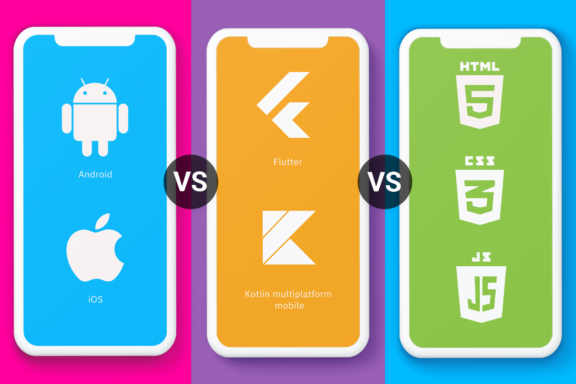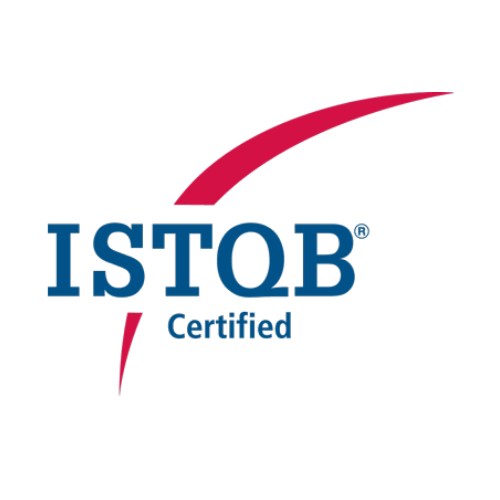This article examines the three main types of mobile app development: native vs hybrid vs web.
We explain how each development type differs from the others. Then we explore the benefits of each and if native app development should still be the default moving forward.
Read on to understand how a mobile app is made and the pros and cons of web, native and hybrid app development.
What type of mobile app development is best in 2021?
There were 35 billion mobile apps downloaded in the first half of the year in 2020. That’s an increase of 13% from 2019 and covers two-thirds of the global population.
iOS and Google’s Android platforms host the bulk of mobile apps. Yet the two technologies are very different. Deciding how to develop for them can make or break an app’s success.
The answer to which type of mobile app development is best is a highly contested debate and at the moment depends entirely on the details of the app development project and your team’s resources. What’s best for one project won’t necessarily be best for another.
However, in 2021, native apps remain important whilst both web and hybrid are growing in popularity for various reasons.
Guide to Web Apps
Web app development uses cross-platform languages like JavaScript, CSS and HTML to produce a mobile app’s UX.
Since the Internet began, coders have built websites using these technologies. Although times have changed, they still form the basis of most content online.
That’s fine for the web but what about mobile apps?
Is a web app different from an ordinary web site? Can it run on Android and iOS? How does that work?
What is a web app and how is it different from a website?
A web app is a responsive website that is designed specifically to be viewed and interacted with on mobile devices – they are dynamic, allow for high levels of customisation and offer a wide range of functions.
A website usually provides a flat experience. One with little activity and which serves up information for the visitor to consume.
A web app introduces interactivity into the mix.
Browsers like Chrome, Safari and Edge, work with user inputs like clicks or taps to produce an interactive experience. It mirrors how ‘normal’ native applications work by pressing buttons or swiping to use the software.
Web applications can run on any device as long as a modern web browser is installed. The user must connect to the Internet as the web app runs online.
How are web apps usually built?
Unlike traditional frameworks, web app development doesn’t need a software development kit (SDK).
As nothing is pre-compiled, a simple text editor can work. However, most developers use reactive frameworks as they make coding easier and more manageable.
The term relates to how data ‘reacts’ with the application. Programmers don’t need to worry about updating the user interface because the framework does it for them.
The top frameworks include Angular by Google, React by Facebook and Vue.js, which we’ll cover later.
Each has its own pros/cons including the learning curve. Yet they all offer an efficient way to develop web applications.
What are progressive web apps?
A progressive web app is a combination of a web app and a mobile app, designed to use APIs and other technologies to deliver an app-like experience via both desktop and mobile devices.
Web apps have limitations. Unlike a native app, they don’t interact with built-in iOS or Android controls. They can’t work with push notifications. They’re not designed to work offline and they don’t download and update from the Google Play/App Store.
Progressive web apps bridge the gap between a web app and a native experience using modern APIs.
They’re standalone applications and work on desktops, laptops and mobile platforms. The user creates a shortcut on their device much like a normal app. It opens it in a browser with no tabs making it appear like it’s a standard app.
A PWA codebase is the same regardless of where it’s installed – which brings us to the biggest advantage of web app development.
Advantages of Web Apps
Perhaps the strongest benefit of using a web app for mobile app development is its ‘write once use anywhere’ capability.
Coders can create a web app then distribute it online. If something needs updating only one codebase gets refactored, not several. Users automatically receive the latest features without the need for opening the app store.
Flexibility is also a huge advantage. Developers can build anything they want and have a world of helpful widgets and snippets to assist them. Responsive CSS also fits content onto the user’s screen no matter its size.
Disadvantages of Web Apps
Web apps don’t offer the full functionality of native apps, they’re not designed to. Web apps use their own components that don’t fit in with standard Material design presentation. The result often looks ‘off’ and can confuse users.
Web apps cannot interact with powerful native features such as camera movement. Because code isn’t pre-compiled, they also suffer from performance issues. The end result is often a choppy experience, especially for animated elements.
One of the biggest flaws of web app development is the lack of presence on the Play/App Store.
Users search for new apps and find them through the app store. If there’s no page to promote it then the user won’t find the app.
Web App Platforms
We’ve touched on reactive frameworks but which is the most popular in 2021?
Google’s AngularJS offers an open-source, single-page development platform. It’s aimed at enterprise-level applications and uses a subset of JavaScript called Typescript.
ReactJS is Facebook’s reactive platform. It’s fast and works with components to make code manageable and it uses JSX files instead of JavaScript to render content.
Vue.js is a popular framework that offers versatility. It provides two-way binding with vanilla JavaScript and implements in minutes.
Angular led the way for years but became eclipsed by React. However, hot on Facebook’s heels is Vue. It’s now a two-horse race according to GitHub star, which is a good indicator of usage.
Web App Examples
Popular examples of web apps include Microsoft 365 and Google apps like Docs and Drive.
PWAs include Twitter Lite, AliExpress and India’s largest e-commerce site Flipkart.
Guide to Native Apps
A native app is an app that is developed for one platform in particular to utilise the device’s full feature set and is only available to download through that platform’s relevant app store (such as Apple’s App Store or the Google Play Store).
A native app targets a specific platform like iOS and Android and works ‘natively’ with all the device’s features.
Unlike a web app, native apps compile, which makes them fast – they can harness controls and manage features like user notifications with no workarounds.
What is a native app and what types are there?
Native app development is the most common development process. This is because Google and Apple promote their own dev tools like Android Studio, which use native code.
Compiled programming languages like Java and Kotlin create native Android apps. Traditionally, Objective-C was the only choice for Apple’s offerings. Now, Swift is seeing a surge in popularity thanks to its easier approach.
These languages are more powerful than JavaScript and HTML. They offer excellent performance and all devices support their code.
Does on native app work on all platforms?
Many businesses require apps for both Google and Apple platforms. The app needs to work on iPhones, Samsung Galaxies, tablets, phablets and everything in between.
Unfortunately, this is where native apps fall down.
Writing an Android app in Java is not the same as coding Swift for iOS. They’re two different languages, just like French and English. Some words sound similar but the device will only run one that it fully understands so two separate apps are required.
That means two codebases, possibly two development teams, two versions of the apps to manage and support and twice the issues to fix if something goes wrong.
What are cross-platform native apps?
A cross-platform native app is an app that uses one code base which makes it compatible with more than one platform or operating system.
To overcome the problems associated with native apps, developers use cross-platform native apps.
Cross-platform native apps use one codebase – which the software then interprets into the correct programming language. This makes them easier to manage and they fit well into modern development cycles like the Agile process.
Examples of cross-platform development SDKs include:
- Flutter
- React Native
- Titanium
- Xamarin
They pre-compile the code to take advantage of working directly with the device, just like native apps do. An iOS app uses the same code as Android but the end products are very different. Regardless, they work and work well.
Advantages of Native Apps
There’s a simple reason why most developers program for native: performance.
For apps that require speed and instant feedback to user input, native development is a must.
Native apps also provide access to the full feature set of the operating system. For example, if the gyroscope plays an important part in the user experience then native is the only viable option.
Using cross-platform native apps also allows simultaneous multi-device development which is cost-effective and scalable over time.
Disadvantages of Native Apps
Why aren’t all apps native in design if it offers the best performance?
The reason is cost.
High-level languages like Java, Swift and Dart (for Flutter) require high-level programmers. It takes years to become adept to use this software. In other words, you get what you pay for.
Native can also over complicate things, especially for simple applications.
In contrast, web apps can produce simple, medium, or complex results and they’re easier to deploy, unlike native apps. With native apps, even a simple edit requires code to recompile and the app uploaded to the app store for another update.
Native App Platforms
Native apps run on their respective platform devices. However, there are lots of different development platforms to choose from outside of Apple and Google’s offerings.
Along with the React Native app SDK, many software companies offer online cross-platform solutions.
Each varies in quality and truthfully most aren’t very good, but they can offer a simple approach to building an app and even use APIs for database support.
Flutter is Google’s new approach to multi-platform app coding. It uses a similar style to the popular React system but can compile for native apps and web and desktop applications. Performance is the same as native yet the code works across different device types.
Native App Examples
The New York Time’s famous crossword is now available on iOS Android, Mac, Windows and on the web thanks to Flutter.
Bloomberg’s app was written in React Native and provides constant news to its users. Previously, two separate apps were created and maintained. Now, there’s one source code and it works everywhere.
Airbnb also uses React Native and is one of the world’s most popular hospitality companies. Their 60-strong team of engineers work every day to make the app even better using React Native components.
Guide to Hybrid Apps
What if a web app could be hosted within a native app?
It could bring the best of two worlds together. One codebase could, in theory, serve multiple platforms. Yet the coding costs could be reduced as low-level language developers aren’t as expensive as Java or Swift coders.
What is a hybrid app?
Hybrid apps are native apps that integrate a web browser to display web apps – they are downloaded in the same way that native apps are but display content to the user in the same way a web app would.
In Android, this is done through a WebView component. In iOS, UIWebView and WKWebView perform this function.
The app either connects to the web to download or stream the content and functionality. Or the files are saved as assets within the app for offline use.
Advantages of Hybrid Apps
Unlike a web app, hybrid mobile apps don’t need a standalone web browser to work. They also have access to a device’s internal features and can communicate with them.
Need a barcode scanner within a web app? That’s no problem with hybrid app development.
Disadvantages of Hybrid Apps
In Android development, a WebView acts as the canvas for the web application. The mobile device or tablet uses this bridge to communicate with the web code and vice versa. For applications that need constant monitoring and use animations, the performance takes a major hit.
Special functionality like printing requires additional code so things aren’t so straightforward. That means tweaking each version to work, breaking the write-once advantage.
Hybrid App Platforms
Hybrid app development platforms include:
- Ionic
- PhoneGap
- NativeScript
Hybrid apps work on all device types because they’re essentially native apps. They install and update via the app stores so look great on tablets and phones alike.
Hybrid App Examples
Evernote’s software assistant is actually a hybrid app. It has great usability and seamless performance so most users believe it’s native.
Instagram also uses hybrid features to support offline saving, as does the Gmail app.
What is the best type of app?
Choosing the right type of mobile app development depends on budget, platform reach and desired outcome.
For simple applications that need to run on any device including laptops, web apps check all the boxes.
They look and act like a native app as users can access them from their home screens. Yet they’re versatile and are relatively inexpensive, depending on the requirements.
Native apps fit most clients’ needs.
They allow users to search and download them from the app stores. They offer a fully integrated experience and can offer any feature required.
Hybrid apps bring the best of both worlds.
One codebase means better reach, which means a larger target audience. Yet they don’t offer the best functionality compared to pure native.
Mobile app development covers a wide base.
Web vs Native vs Hybrid means choosing an option that will have consequences throughout the app’s lifecycle. That’s why it’s essential to get the right development team that knows what’s best for your business.
How to Choose Between Web Apps, Native Apps or Hybrid Apps
After reading this article you should have a clearer understanding of the differences between web, native and hybrid mobile apps – which is a step in the right direction when it comes to deciding which is best for your project.
Analyse the benefits and disadvantages of each option in context with your project’s requirements and user needs. You must be aware of the tradeoffs and hurdles associated with your selected approach to maximise efficiency and quality.
Consider the following when choosing between web, native and hybrid app types:
- Is the app development project on a tight deadline?
- How limited or expansive is the project budget?
- What will the app set out to achieve?
- What features will the app need to have to achieve what it is intended to?
- How complex are these features?
- What kind of experience is the app supposed to give its users?
- Can the app be developed in-house or will it be outsourced?
- What distribution channels will be used?
Coderus offers innovative mobile app development solutions.
We specialise in developing cross-platform mobile applications using native, web and hybrid methods. There’s no need to find another development team to target Android or iOS. We do it all.
Get in touch to discuss your requirements.
We can create and implement the right strategy to ensure your business app succeeds.























